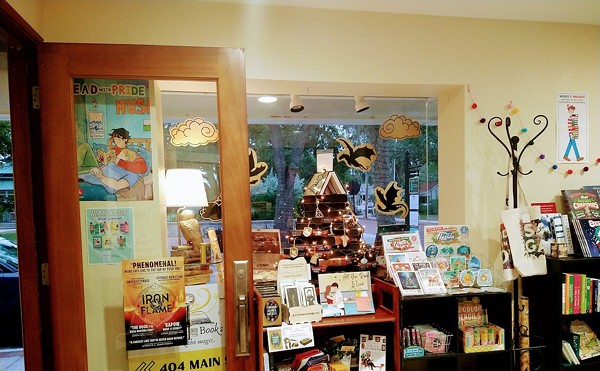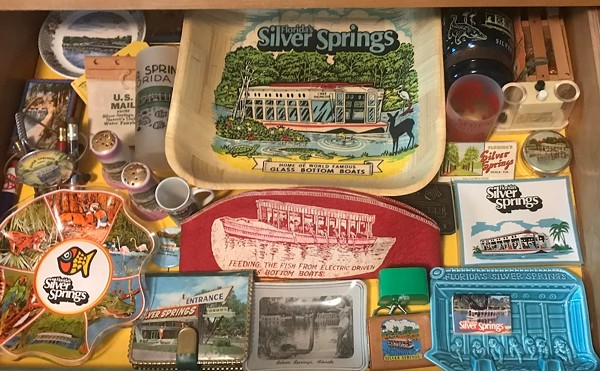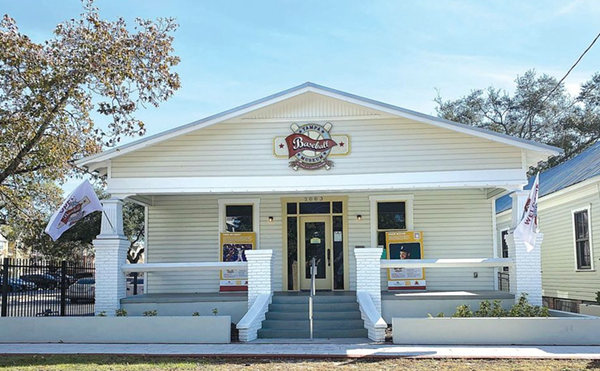July 12th's Tampa Zine Fest turned out to be a great opportunity, as always, for networking among like-minded weirdos. Among a lot of other great work, I honed in on Mitchell Goodrich, whose screen-printed, multi-fold zines, full of extra goodies and with a developed artistic sensibility, were some of the best of the show.
Goodrich's small 'zine imprint, which publishes his own work and that of fellow travelers like Niv Bavarsky, is called Get Lost Press. But despite the toughie pose, in person Goodrich is one of those achingly sweet young artists who seems like he'd do anything for just about everybody. He seems to have picked that up from his stretch in that hipster mecca that isn't Portland - Baltimore - with its proud legacy of aggressive posi-vibers like Dan Deacon.
What Goodrich was generous enough to do for me was answer a few questions over email - questions about his art, about Baltimore, and about coming back to the Bay Area.
David Z. Morris: First, you're from Florida, right? Tell me about how you ended up in Baltimore, and what it was like being there?
Mitchell Goodrich: Yeah, I grew-up here in St. Pete and ended up in Baltimore at one of the funny acronym art schools—the Maryland Institute College of Art, or MICA—to get my bachelors in art history and illustration. Baltimore can be a really fun place. There is an excellent zine fest there each March, called the Publications and Multiples Fair, and every May the city goes movie crazy during the Maryland Film Festival.
Fancy pizza, dance parties, and kitsch reign supreme there. Warehouse music venues and independent art galleries are pervasive throughout the city, and every event ends with a sweaty DJ set. Korean BBQ is a must at 3 AM, Old Bay goes on everything, trading glances with John Waters is an eventuality, and of course, chicken boxes galore. Unfortunately, skeevy landlords tend to get annoying and friends move in different directions, so plans to visit become sufficient.
DZM: How does it feel to be getting back to Florida?
MG: It feels great! I really missed the sound of thunder, so these summer storms have been a comfort. Biking around St. Petersburg, I've glimpsed a lot of wonderful changes, new shops, and some really impressive murals, but I'm still hoping the whole condo ideology gives way to conversions of our beautiful revivalist architecture at some point.
The Ale and the Witch is a craft brew paradise, the Pride parade was exhausting fun, and the Aaron Siskind show at the MFA is stunning. I visited Planet Retro for the first time the other weekend and not only did I spot a Leadbelly vinyl on the wall and a copy of Paul's Boutique in the first bin I checked, but Sleep's Dopesmoker was playing over head. I'm in danger of spending a lot of money there in the future...
DZM: Do you have plans now that you're back? How do you envision your "art career" unfolding, or do you think of it in those terms?
MG: At the moment, I think of my art practice less in terms of a career, just in order to free myself of the pressure to morph my work for broad marketability. I prefer working full-time in an art-related field and allowing my personal work to remain personal. It's more comfortable as an outlet than as an income.
While in Baltimore, I collaborated with a friend on a screening series focused on obscure art films. Basically, the harder a time you had locating a copy of the movie, the better suited it was to share. We would have open discussions after each screening that kept everyone engaged. I'd love to do something like that here. Less talk about Spring Breakers, more about Loren Cass.
DZM: One of the 'zines I saw was drawings of hotdogs and pizza. I don't remember if that was your work, but what do you think of the relationship between 'hibrow' and 'lowbrow' art? Does that matter much anymore?
MG: That was probably Hut Dugs, my fanzine dedicated to hot dogs.
Those oft-pejorative terms, along with "middlebrow," can be very dangerous and are always a point of contention. They lump artworks into vague categories and don't identify formal qualities, style, or conceptual goals, but subjectively apply cultural value. With that said, the distinction matters when you are evaluating the content you, yourself consume and, perhaps especially so, when critiquing commercial availability. We are omnivores, and while we may need to have seen Point Break enough times to recite Gary Busy's every rant verbatim, we should also watch something like an Ozu or Agnes Varda every once in a while for health. It'a all about balance.
What I'm really interested in though, is the convergences of these realms. Stuff like the failure that is Johnny Mnemonic—the artist Robert Longo's lone attempt at filmmaking—or the brilliant '50s meta-melodramas of Douglas Sirk, such as Imitation of Life (the title says it all).
DZM: I got the zine of collages from 2011. Do you think of the object photographs as sculpture, painting, photography, what? Does it matter?
MG: I think of them as collages. The distinction matters to me in terms of construction, but as with anything else, I don't mind if the viewer has a completely different reading. I had just found out about B. Wurtz's sculptures when I first started making them, but since I wasn't sure where to stop with the constructions, I would photograph them as sketches. Later I began to manipulate the photos, erasing elements in a move inspired by Paul Pfeiffer. That's when I decided it was important for them to remain two-dimensional. The camera or scanner is merely the means of flattening them, but shouldn't inform the content in any way.
DZM: What are you trying to figure out or express with the use of space in those pieces?
MG: Eventually, I would like to abolish space from them altogether. As in a standard representational painting, the depicted objects are reflections of something in the tangible world, but lay physically flat on the same plain as the negative space. I am attempting to underline that flatness in my work. I include elements generally used as tools for creating the illusion of pictorial space, such as horizon lines and shadows, but only in order to point to those tools as fallacies.
DZM: What about the selection of objects? I can see there's a pretty strong color throughline, but what else is guiding you?
MG: It may sound tacky, but I think of them as free-form puzzle pieces. So color and value play a large role, but so does consideration of how flexible they will remain when designing the various compositions. The strictest rule is that they are never paid for, or at least not bought with the sole purpose of using them for a collage. Thus, litter plays a very prominent role. The compositions hopefully produce a space to reconsider these objects of cultural detritus by extending their life, granting them a role beyond what is intended, and figuring out how they work symbolically when juxtaposed with some other completely foreign item.
DZM: What kind of future work do you have in mind?
MG: Make more zines and collaborate with more artists. The next stop for Get Lost is RIPE, the Rhode Island Independent Publishing Expo in Providence. Those events are a lot of fun and great excuses to prepare new work, promote yourself, socialize, and empty your bank account.
I really want dive deeper into film programming. I am on the screening committee for the Maryland Film Festival and I participated in the student symposium at the Telluride Film Festival in 2011. I love seeing what's new, talking to filmmakers, and sharing interpretations with friends. The screening series is a serious idea, so if anyone has a space where it could be held, that would be great! Beyond that, I'm always on the hunt for an after hours programming job/internship with a local film festival.
Thanks again!
(Author's Note: Thanks to Georgia Ann Hourdas for help with the artistic inquiries.)

















